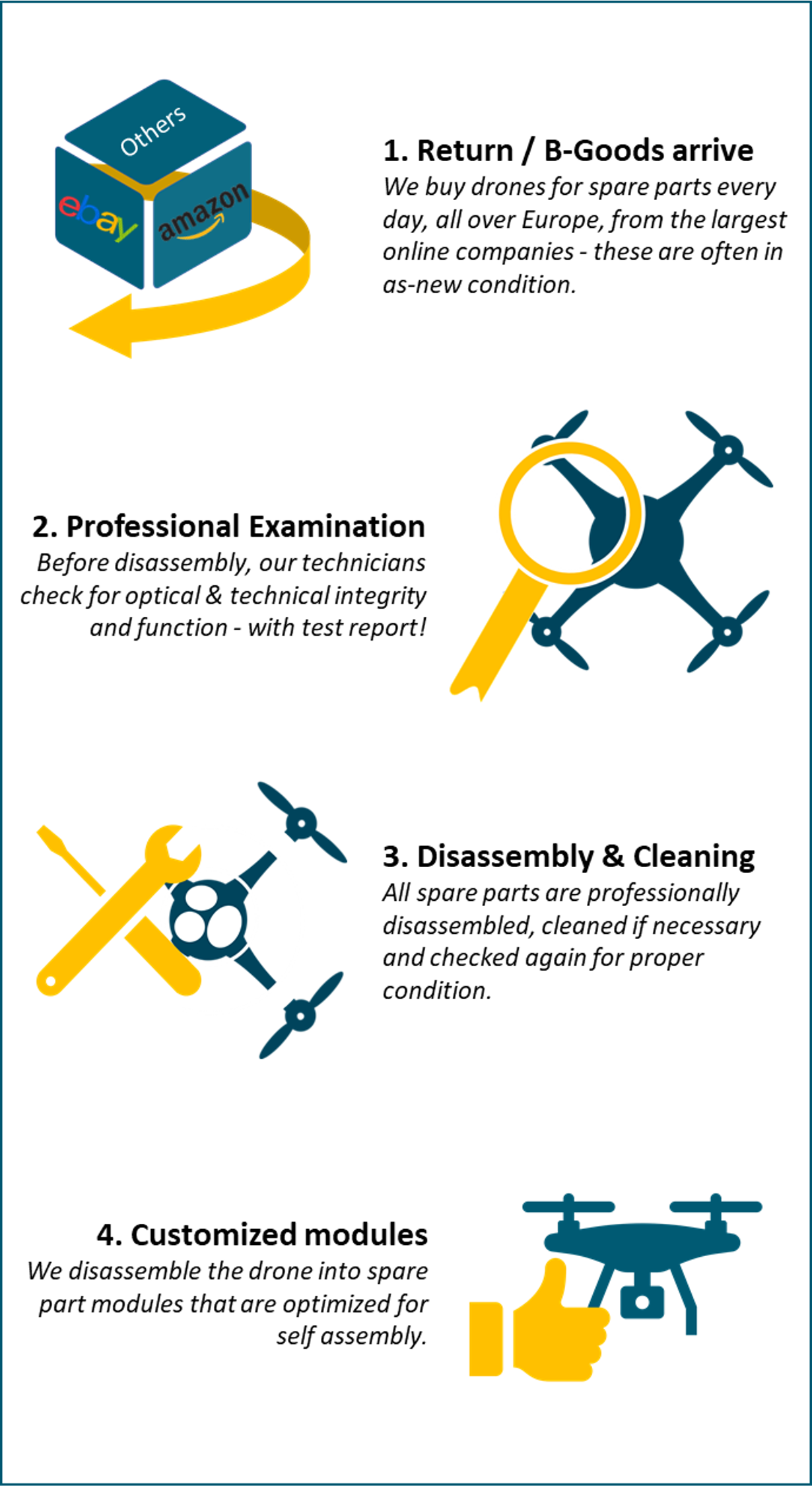DJI P4 RTK - Visionary Intelligence. Elevated Accuracy.
Upgrade your next mapping mission with the P4 RTK – DJI's most compact and accurate low altitude mapping solution.
Next Generation Mapping
DJI has rethought its drone technology from the ground-up, revolutionizing its systems to achieve a new standard for drone accuracy – offering P4 RTK customers centimeter-accurate data while requiring fewer ground control points.
- 1cm+1ppm RTK Horizontal Positioning Accuracy
- 1.5cm+1ppm RTK Vertical Positioning Accuracy
- 5cm* (*When flying at 100m height, 2.7cm GSD, sunny.) Absolute Horizontal Accuracy of Photogrammetric Models
Key Features
- RTK Module
- 1" CMOS Sensor
- GS RTK APP
- TimeSync
- OcuSync
- D-RTK 2 GNSS Mobile Station
-
Centimeter Level Positioning System
A new RTK module is integrated directly into the P4 RTK, providing real-time, centimeter-level positioning data for improved absolute accuracy on image metadata. Sitting just beneath the RTK receiver is a redundant GNSS module, installed to maintain flight stability in signal-poor regions such as dense cities. Combining both modules, the P4 RTK is able to optimize flight safety while ensuring the most precise data is captured for complex surveying, mapping and inspection workflows. Fit the P4 RTK to any workflow, with the ability to connect this positioning system to the D-RTK 2 Mobile Station, NTRIP (Network Transport of RTCM via Internet Protocol) using a 4G dongle or WiFi hotspot, or store the satellite observation data to be used for Post Processed Kinematics (PPK).
Gather Accurate Data with TimeSync
To take full advantage of the P4 RTK’s positioning modules, the new TimeSync system was created to continually align the flight controller, camera and RTK module. Additionally, TimeSync ensures each photo uses the most accurate metadata and fixes the positioning data to the center of the CMOS – optimizing the results from photogrammetric methods and letting the image achieve centimeter-level positioning data.
Precise Imaging System
Capture the best image data with a 1-inch, 20 megapixel CMOS sensor. The mechanical shutter makes mapping missions or regular data capture seamless as the P4 RTK can move while taking pictures without the risk of rolling shutter blur. Due to the high resolution, the P4 RTK can achieve a Ground Sample Distance (GSD) of 2.74 cm at 100 meters flight altitude. To ensure each P4 RTK offers unparalleled accuracy, every single camera lens goes through a rigorous calibration process where radial and tangential lens distortions are measured. The distortion parameters gathered are saved into each image’s metadata, letting post-processing software adjust uniquely for every user.
Purpose-Built Flight Planning Application
A new GS RTK app allows pilots to intelligently control their P4 RTK, with two planning modes – Photogrammetry and Waypoint Flight – alongside a more traditional flight mode. The planning modes let pilots select the drone’s flight path while adjusting overlap rate, altitude, speed, camera parameters and more, offering an automated mapping or inspection workflow. The GS RTK app has been built with its users in mind and therefore has a range of features built for specific mapping or inspection workflows. The app has implemented direct loading of KML area files for in-office flight planning, a new shutter priority mode to keep exposure consistent across all photos and a strong wind alarm to warn pilots of adverse conditions.
Mobile SDK Supported
The P4 RTK is compatible with the DJI Mobile SDK, opening up its functions to automation and customization through a mobile device.
OcuSync Transmission System
Enjoy stable and reliable HD image and video transmission at distances of up to 7 km, great for mapping larger sites. *Unobstructed, free of interference, when FCC compliant. Maximum flight range specification is a proxy for radio link strength and resilience. Always fly your drone within visual line of sight unless otherwise permitted.
Seamless Compatibility with D-RTK 2 Mobile Station
Support your P4 RTK missions with the D-RTK 2 Mobile Station – providing real-time differential data to the drone and forming an accurate surveying solution. The Mobile Station’s rugged design and OcuSync 2.0 transmission system ensures you can gain centimeter-level accurate data with your P4 RTK in any condition.
Start Mapping Today
With a built-in flight planning app (GS RTK) and aneasymethod to collect RTK data (RTK Network or D-RTK 2 Mobile Station), pilots have a full solution for any surveying, mapping or inspection workflow – right out of the box.
In the Box:
- 1x P4 RTK Aircraft
- 1x Remote Controller with Built-in Screen
- 4x Propeller (Pairs)
- 2x Intelligent Flight Battery
- 1x Intelligent Flight Battery Charging Hub
- 1x Power Adapter
- 1x AC Power Cable
- 1x Intelligent Battery
- 1x Intelligent Battery Chrging Hub
- 1x Micro-USB Cable
- 1x Male-to-Male USB Cable
- 1x 16GB Micro-SD Card
- 1x Carrying Case
- 1x D-RTK 2 GNSS Mobile Station
- 1x D-RTK 2 GNSS Tripod
- 1x Terra Pro (Licence 1 Year)
Product Video
Product Video
Product Video 3
Product
2.Supports hot swappable batteries.
3.Pre-installed GS RTK App can run Photogrammetry, Waypoint and other mission types.
4.OcuSync video transmission.
2. Connect remotely via a 4G Dongle to a custom RTK network using a NTRIP account.(RTCM3.2)
3. Connect remotely via a WiFi hotspot to a custom RTK network using a NTRIP account. Not available in Europe.(RTCM3.0/RTCM3.1/RTCM3.2)
PPKRAW.bin is an RTCM3.2 MSM5 format that stores satellite observation data and ephemeris data.
Rinex.obs is a Rinex file format that is created after transcoding.
Timestamps.MRK is a ASCII format that stores exposure and time stamp.
(1)DJI Base Station: Connect DJI D-RTK 2 High-Precision GNSS Mobile Station and the remote controller via a USB cable to upload the PPK data onto the base station. After the server acquires the data from the aircraft and the D-RTK 2 Mobile Station, it will start PPK calculation automatically.
(2)RINEX Base Station: Convert the satellite observation values received by third-party base stations into standard RINEX format, then import the PPK source data to the remote controller and upload them to the cloud server for PPK calculation.
(2)Users can also manually enter the longitude and latitude information of where the base station is set up, as well as the distance between the bottom of the base station and the antenna phase center (APC). With this information, the Cloud PPK Service will run calculations based on the antenna phase center information entered by the user.
(3)The Cloud PPK Service can also acquire the location of the antenna phase center through Single Point Positioning (SPP) with RINEX data. These coordinates will be used for PPK calculation. *
* Currently only available in Europe.
(1) Instantaneous measurement
(2) Average measurement using 10 values collected during 2 seconds
(2)For average measurement: it is recommended that the RTK signal be “FIX”.
You can also update the drone and remote controller simultaneously through the GS RTK app. First you connect the remote controller to the aircraft with OTG and USB cables, then follow the procedures explained in the remote controller's GS RTK app.
In DJI Terra: waypoints can be at most 2km apart, and at most 99 waypoints can be set. The total distance of a waypoint mission cannot exceed 40km, in photogrammetry mode the max distance is 100km.
(2)Set the mapping area: manually set the mapping area or import kml files;
(3)Adjust the grid size and direction;
(4)Adjust parameters such as camera parameters and overlap rate.
(2)Select Waypoint Flight, start adding waypoints with RTK enabled, the system will automatically record the absolute altitude of each waypoint;
(3)Select Absolute Altitude in the Height popup window when you perform the operation.
(1)The GCP is set in a different coordinate system or height datum from that of the Phantom 4 RTK’s position. Please make sure they are in the same coordinate system.
(2)The Phantom 4 RTK’s RTK status is not “FIX”. Ensure that the RTK status is “FIX” when collecting data.
(3)The internal camera parameters used by the post processing software are not accurate.
DJI Terra - Digitalisieren Sie die Welt
Analysieren und visualisieren Sie Ihre Umgebung mit DJI Terra, einer benutzerfreundlichen Kartierungslösung für Branchenprofis zur professionellen Erzeugung Digitaler Daten aus echten Szenarien.
Planen Verarbeiten Analysieren und Ausführen
- Planung von Flugaufträgen
- Datenerfassung
- Bereichskartierung
- Datenanalyse
Auftragstypen
Wegpunkteplanung
Erstellen Sie effiziente Flugrouten mit vordefinierten Aktionen an den jeweiligen Wegpunkten. Schlüsselfunktionen wie beispielsweise Geschwindigkeit, Flughöhe und Gimbal-Ausrichtung können vor dem Flug festgelegt werden. Für komplexere Flugaufträge und Flüge in beengten Verhältnissen, die ein sehr hohes Maß an Detailgenauigkeit benötigen, steht jetzt eine 3D-Flugvisualisierung zur Verfügung, um Flüge in bestehenden 3D-Modellen zu planen und zu simulieren.
Bereichsplanung
In nur wenigen Schritten lassen sich komplexe Flugaufträge automatisieren, was die Erstellung von Karten und Modellen für weitere Analysen stark vereinfacht.
Schrägaufnahmenplanung
Wenn Präzision unerlässlich ist und eine hohe Detailgenauigkeit unverzichtbar ist, bieten Flugaufträge mit Schrägaufnahmen die Möglichkeit detailgetreue 3D-Modelle zu erstellen. Hierbei nimmt die Kamera Bilder aus einem Neigungswinkel auf, um ein noch schärferes und detaillierteres Bild des Zielobjekts zu erhalten.
Kartierung
Kartierungen in Echtzeit
Kartierung in Echtzeit bietet die Möglichkeit schnell ein 2D-Orthomosaik eines ausgewählten Bereichs zu erstellen. Dies ist nicht nur ideal für die Erstellung detaillierter Flugrouten in abgelegenen Gebieten, sondern auch für Aufträge mit begrenzten Zeitfenstern.
2D-Rekonstruktion
Generieren Sie Orthomosaike mit hoher Auflösung, um präzise Messergebnisse für wichtige Projekte zu erhalten.
3D-Rekonstruktion
Erhalten Sie eine gestochen scharfe und realistische Repräsentation eines Gebiets. Diese Technologie lässt sich für eine Vielzahl an industriellen Anwendungen einsetzen, wie beispielsweise bei Baufortschritten und der Unfallrekonstruktion.
Datenanalyse
2D- und 3D-Messungen:
Erfassen Sie die Abmessungen eines Bereichs mit benutzerfreundlichen Messwerkzeugen für Entfernungen, Flächen und Volumen.
Koordinaten
Entfernung
Fläche
Volumen
Anmerkungen
Fügen Sie Anmerkungen an bereits existierende Modelle an, was für verbesserte Kommunikation im Verlauf eines Projekts sorgen kann.
Inspektionen durch detaillierte Fotos
Fotos mit einem 3D-Referenzpunkt können auf Abruf separat dargestellt werden. Die Daten der 3D-Modelle und Fotos geben Ihnen mehr Freiheit bei Inspektionen und der doppelten Möglichkeit zur Überprüfung von Details.
Nahtlose Integration mit Drohnen von DJI
DJI Terra ist mit folgenden Drohnen der Phantom 4 Serie kompatibel:
Phantom 4 RTK
Phantom 4 Pro V2.0
Phantom 4 Pro+ V2.0
Phantom 4 Pro
Phantom 4 Advanced
Phantom 4.
Beginn einer neuen Generation von Kartierungslösungen
Nutzen Sie neueste Kartierungslösungen mit KI-Technologie und bringen Sie industrielle Projekte auf eine neue Ebene der Möglichkeiten. Sei es Objektklassifizierung oder Inspektionen, entwickeln Sie aufgabenspezifische Kartierungslösungen zur Durchführung Ihrer Aufträge.
Datenerfassung
Definieren Sie Ziele, planen Sie Flugaufträge und automatisieren Sie die Datenerfassung aus der Luft.
Datenverarbeitung
Nutzen Sie Technologie zur Bilderkennung und generieren Sie Daten in 2D und 3D, was für eine realistischere Darstellung Ihres Zielobjekts, der Umgebung oder der gesamten Infrastruktur.
Datenverwertung
Nutzen Sie Werkzeuge und Techniken aus dem Bereich des maschinellen Lernens, was zur Anwendung in vielen verschiedenen Industriezweigen zur bedarfsgerechten Klassifizierung genutzt werden kann.
Ausführung
Automatisieren Sie Prozesse mit Maschinensteuerung und setzen Sie die Ergebnisse effizient in Aufgabengebieten wie beispielsweise der Schädlingsbekämpfung, der Überwachung von Baufortschritten und dem Materialtransport ein.
Terra Lizenzen
| Funktionen/ Version |
Advanced |
Pro |
| 2-D Kartierung in Echtzeit |
JA |
JA |
| Anwendungen in der Landwirtschaft |
JA |
JA |
| Import von KML-Dateien |
JA |
JA |
| 2D-Rekonstruktion (Field) |
JA |
JA |
| 2D-Rekonstruktion (Urban) |
JA |
JA |
| 3D- Rekonstruktion |
NEIN |
JA |
| 3D Flugaufträge |
NEIN |
JA |
0


